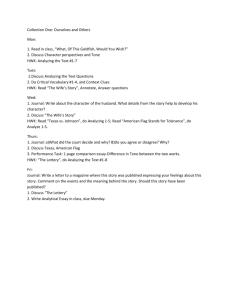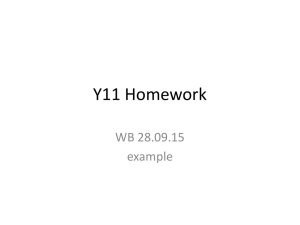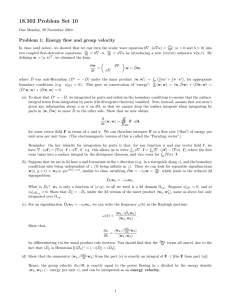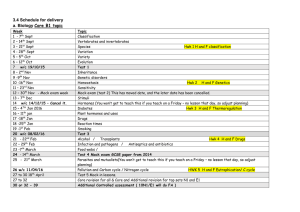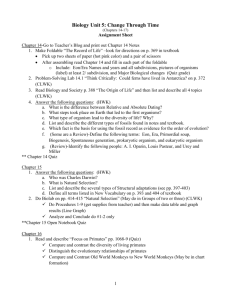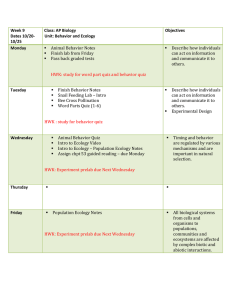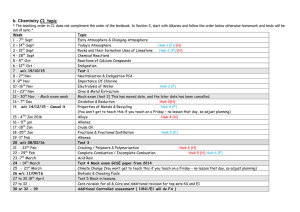HDF 390 Syllabus
advertisement
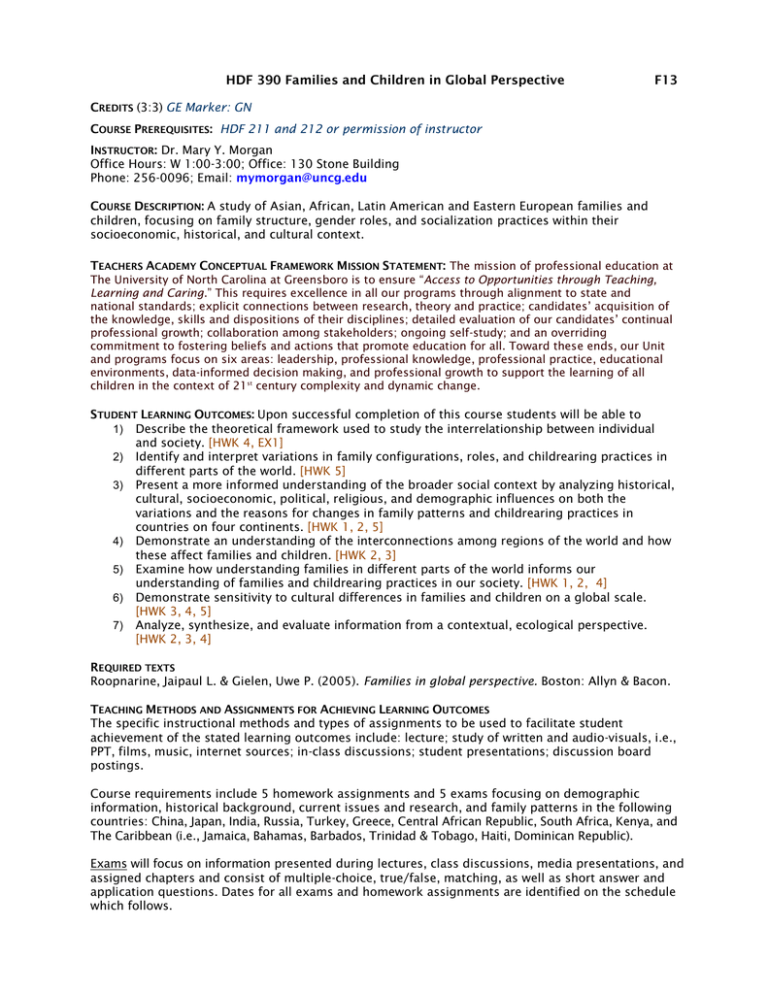
HDF 390 Families and Children in Global Perspective F13 CREDITS (3:3) GE Marker: GN COURSE PREREQUISITES: HDF 211 and 212 or permission of instructor INSTRUCTOR: Dr. Mary Y. Morgan Office Hours: W 1:00-3:00; Office: 130 Stone Building Phone: 256-0096; Email: mymorgan@uncg.edu COURSE DESCRIPTION: A study of Asian, African, Latin American and Eastern European families and children, focusing on family structure, gender roles, and socialization practices within their socioeconomic, historical, and cultural context. TEACHERS ACADEMY CONCEPTUAL FRAMEWORK MISSION STATEMENT: The mission of professional education at The University of North Carolina at Greensboro is to ensure “Access to Opportunities through Teaching, Learning and Caring.” This requires excellence in all our programs through alignment to state and national standards; explicit connections between research, theory and practice; candidates’ acquisition of the knowledge, skills and dispositions of their disciplines; detailed evaluation of our candidates’ continual professional growth; collaboration among stakeholders; ongoing self-study; and an overriding commitment to fostering beliefs and actions that promote education for all. Toward these ends, our Unit and programs focus on six areas: leadership, professional knowledge, professional practice, educational environments, data-informed decision making, and professional growth to support the learning of all children in the context of 21st century complexity and dynamic change. STUDENT LEARNING OUTCOMES: Upon successful completion of this course students will be able to 1) Describe the theoretical framework used to study the interrelationship between individual and society. [HWK 4, EX1] 2) Identify and interpret variations in family configurations, roles, and childrearing practices in different parts of the world. [HWK 5] 3) Present a more informed understanding of the broader social context by analyzing historical, cultural, socioeconomic, political, religious, and demographic influences on both the variations and the reasons for changes in family patterns and childrearing practices in countries on four continents. [HWK 1, 2, 5] 4) Demonstrate an understanding of the interconnections among regions of the world and how these affect families and children. [HWK 2, 3] 5) Examine how understanding families in different parts of the world informs our understanding of families and childrearing practices in our society. [HWK 1, 2, 4] 6) Demonstrate sensitivity to cultural differences in families and children on a global scale. [HWK 3, 4, 5] 7) Analyze, synthesize, and evaluate information from a contextual, ecological perspective. [HWK 2, 3, 4] REQUIRED TEXTS Roopnarine, Jaipaul L. & Gielen, Uwe P. (2005). Families in global perspective. Boston: Allyn & Bacon. TEACHING METHODS AND ASSIGNMENTS FOR ACHIEVING LEARNING OUTCOMES The specific instructional methods and types of assignments to be used to facilitate student achievement of the stated learning outcomes include: lecture; study of written and audio-visuals, i.e., PPT, films, music, internet sources; in-class discussions; student presentations; discussion board postings. Course requirements include 5 homework assignments and 5 exams focusing on demographic information, historical background, current issues and research, and family patterns in the following countries: China, Japan, India, Russia, Turkey, Greece, Central African Republic, South Africa, Kenya, and The Caribbean (i.e., Jamaica, Bahamas, Barbados, Trinidad & Tobago, Haiti, Dominican Republic). Exams will focus on information presented during lectures, class discussions, media presentations, and assigned chapters and consist of multiple-choice, true/false, matching, as well as short answer and application questions. Dates for all exams and homework assignments are identified on the schedule which follows. 2 Homework Assignments You will be assigned a different country for each of the following homework assignments; the assignment list will be posted the first week of classes. The format and examples of the homework assignments are included on the following pages. Each homework assignment will be presented in class during the discussion of that country; a daily schedule is outlined below. Assignments should be turned into class the day it’s presented; make-ups or revisions are not accepted. Following class discussion, homework assignments should be posted on Blackboard. The rubric for evaluating homework assignments is shown below. HWK1 [SLO 3, 5] Facts about country: List population, life expectancy, infant mortality, adult literacy, poverty rate, unemployment, occupations, languages, ethnic groups, currency, government type, capitol in class. Use the World Factbook at https://www.cia.gov/cia/publications/factbook/index.html for this information. Turn in a one-page list of facts. HWK2 [SLO 3, 4, 5, 7] Brief historical background: List early civilizations, types of government, important contributions, famous people, role in WWII, current issues.) Use web source for this. Turn in two-page (front & back) list. HWK3 [SLO 4, 6, 7] Current event about country: Identify source—e.g., news from web, magazines, radio/TV; summarize event; and connect to other info on country. Turn in a one-page summary. HWK4 [SLO 1, 5, 6, 7] Research article summary: Identify article citation, sample, methods, findings, and extent to which research fits material discussed in class. Turn in one-page summary. HWK5 [SLO 2, 3, 6] Chapter discussion: Identify main points from chapter in your text in a one-page, front and back, outline. Write two questions for discussion. Turn in two-page (front & back) outline and questions. EVALUATION AND GRADING This rubric will be used to evaluate your homework assignment. Homework Rubric .5 PROMPTNESS PRESENTATION ORGANIZATION ACCURACY 1 1.5 2 Submits assignment more than 2 days late Submits assignment within 48 hours of due date Submits assignment by due date but doesn't present in class Submits assignments on time and presents in class X1 Utilizes poor spelling and grammar; assignments appear "hasty" Some spelling and grammatical errors Few grammatical or spelling errors Consistently grammatically correct with rare misspellings X1 Lack of clarity and organization Minimal organization and clarity of ideas Ideas are mostly stated clearly; material is easy to read Ideas are expressed in a clear and concise manner X1 Information is inadequate with several inaccuracies Inaccurate info included; assignment is short and offers limited insight into topic Information is mostly accurate and adequate but further insight is needed Information is accurate and thorough X2 3 WORKING IN PAIRS. The purpose of working in pairs on your homework assignments is to provide for some interaction and an opportunity to learn from each other in this size of class. So figure out a way so you both benefit. You will turn in one assignment with both of your names on it, and you will both get the same grade. The homework assignments are worth 35% and the exams 65% of the total grade as follows: HWK 1 (Facts) = 6% EX1 (China & Japan) = 13% HWK 2 (History) OR EX2 (India & Russia) = 13% HWK 4 (Research) = 7% EX3 (Turkey & Greece) = 13% HWK 3 (Event) = 6% EX4 (Central African Republic & South Africa = 13% HWK 5 (Discussion) = 7% EX5 (Kenya & The Caribbean) = 13% HWK 6 (TBA) = 9 Grades are based on a 10-point scale (90-100% = A, 80-89% = B; 70-79% = C; 60-69% = D; below 60% = F). Pluses (% ending in 7, 8, and 9) and minuses (% ending in 0, 1, and 2) will be assigned when final grades are determined. Scores on assignments and exams will be posted on blackboard where you can keep track of your grade throughout the semester. ADDITIONAL COURSE POLICIES ACADEMIC INTEGRITY is the pursuit of scholarly activity free from fraud and deception and is an educational objective of this institution. Violating academic integrity is considered a serious offense by the university and is treated accordingly. Academic dishonesty includes, but is not limited to, cheating on exams, having unauthorized possession of exams, fabricating information or citations, facilitating the academic dishonesty of others, and submitting the work of another person as your own (plagiarism). Academic dishonesty dev result in a failing grade for the particular assignment or exam, a failing grade for the entire course, or suspension or expulsion from the university. Each student is required to sign the Academic Integrity Policy on all major work submitted for the course. Refer to UNCG Undergraduate Bulletin at http://web.uncg.edu/reg/Bulletin/Current/AcaRegs/AcademicIntegrity.aspx ATTENDANCE: Students are expected to be in class, on time, and stay until the end of each class. Students who miss the first week of class without notification will be dropped from the course. More than 3 absences will result in the loss of one exam point for each class missed. Students are responsible for what happens in class when an absence does occur. This means you should contact a classmate for information rather than the instructor or post questions on Blackboard (see next item). QUESTIONS: If you have a question about class or an assignment, post it on the Q&A section of the discussion forum on Blackboard. Check this forum before posting your question, and if you need clarification on a question that has already been answered, reply to that post. CLASS PARTICIPATION in the form of comments, questions, and active engagement in classroom activities is strongly encouraged. I assume that students share equally in the learning process, which means that you are expected to attend class, pay attention and participate in class discussion and activities, complete all class assignments and exams, and read your text prior to class discussion. DUE DATES: Homework must be presented and submitted in class on the due date for full credit. No make-up exams, make-up homework, or extra credit will be given. EMERGENCIES: If you have an emergency that interferes with your ability to complete the work in this course, please let the instructor know immediately. If you cannot come for a scheduled appointment, please contact me ahead of time. My office, phone number, and email address are listed above. Note: The instructor reserves the right to change the syllabus as necessary. You are responsible for all changes to the syllabus and all information presented during class time, regardless of whether or not you attended class. Develop a plan for keeping informed without asking the instructor to repeat what you missed. 4 TOPICAL OUTLINE 19aug 21aug 23aug CH1 14oct 16oct Fall Break China 18oct Greece Greece Intro video: Tank Man Qs Disc Qs 26aug 28aug China 30aug China China 4sept Labor Day No Class Exam 3 Japan facts/hist video: Japan disc 9sept event/research 11sept Japan 28oct Central African Republic 13eb Japan Exam 1 South Africa fact/hist video/web: S Africa event/research video: Japan 16sept India 20sept India fact/hist video: India India disc 23sept India event/research video: Missing Girls 25sept South Africa Russia Russia 30sept Russia disc disc video: Kenya2 18nov 4oct Turkey [India/Russia] Turkey event/research fact/hist video: Greece video: Kenya-Where Women Rule 20nov background (dr. morgan) 22nov The Caribbean disc (dr. morgan) 25nov 27nov Thanksgiving 29nov Break [Kenya/Ghana/ Caribbean] 11oct Greece 15nov video: Caribbean Exam 5 fact/hist slides: Turkey 9oct Exam 4 Kenya The Caribbean Ghana 2oct 7octb Turkey fact/hist slides: Kenya1 slides: Ghana Exam 2 event/research Review Kenya Kenya disc hist slides: Russian Family 8nov 13nov Kenya event/research Russia fact Music: Tchaikovsky disc event/research 11nov 27sept video: India (finish) South Africa [CAR/SAfrica] continue disc web: S Africa 18sept 2nov 6nov [China/Japan] disc Central African Republic 30oct 4nov South Africa 25oct disc fact/hist video: CAR 6sept Japan 23oct Central African Republic event/research 2sept event/research 21oct [Turkey/Greece] disc video: China facts/hist disc OR Exam 5 2dec [Kenya/Ghana/ Caribbean] T 3dev Reading Day 7Dev noon-1:30 OR Exam 5 [Kenya/Ghana/ Caribbean] 5 LIST OF READINGS & VISUALS CHPT 1 Families in global perspective: Introduction (See outline on Blackboard) CHPT 4 The family in mainland China The Tank Man (PBS film) 2006 Preschool in 3 Countries (video) CHPT 5 The changing Japanese family JAPAN 2000: CHANGING LIFESTYLES (VH9324) 1998 Preschool in 3 Countries (video) CHPT 6 Changing patterns of family life in India IMAGES OF INDIA (VH9087) 1998 Indian Wedding Asia Eastern & Southern Europe CHPT 16 The Russian family The Kapralov Family (Material world: A global family portrait) 2006 (ppt) CHPT 10 Contemporary Turkish families TURKEY: A LAND UNIQUE (turkishembassy.org—5 min history) Turkish Cuisine 2006 (ppt) CHPT 12 Families in Greece MY BIG FAT GREEK WEDDING (VH11054) 2002 CHPT 20 Families in Central African Republic Dr. Morelli’s Efe in central African (video) 1980s CHPT 21 Family life in South Africa Intro to GANDHI; web pictures Blackboard Luo families in Kenya Slides from Kenya 1993 Kenya: Where Women Rule (DV3670) 2006 Africa Slides from Ghana 2000, 2008 Latin America CHPT 18 Caribbean families in English-speaking countries LIFE + DEBT (VH10851) 2001 FORMAT FOR HOMEWORK ASSIGNMENTS AND EXAMPLES See following pages 6 HWK 1 FACTS—FORMAT COUNTRY NAME FACTS ABOUT COUNTRY INSTRUCTIONS: Download a map and find information for each of the following using the World Factbook http://www.cia.gov/cia/publications/factbook/. Post one page including map, facts, and website. Use the following U.S. facts sheet as a guide [on the next page]. MAP DEMOGRAPHICS AREA (SQ KM PLUS COMPARISON) POPULATION DENSITY [DIVIDE POPULATION BY AREA] URBAN-RURAL FERTILITY RATE POPULATION UNDER 15 ETHNIC DIVERSITY LANGUAGE(S) HUMAN DEVELOPMENT INDEX (HDI) LIFE EXPECTANCY INFANT MORTALITY (M:F) LITERACY (M:F) POVERTY RATE GDP PER CAPITA HEALTH RISKS (HIV/AIDS, INFECTIOUS DISEASES, OBESITY)—PREVALENCE, WORLD RANK, DEGREE OF RISK INSTITUTIONAL CONTEXT (PARTIAL) GDP (PURCHASING POWER PARITY) —WORLD RANK RELIGION GOVERNMENT TYPE HWK 2 HISTORY—FORMAT COUNTRY NAME BRIEF HISTORY INSTRUCTIONS: Find historical background for your country on the web and use the outline below to organize it. Identify 2-5 facts/events for each category. Do not copy several pages of chronological history. Post one page only; include website(s) used. Use the following summary of British history as an example of how to do this assignment. OUTLINE: Earliest civilizations Types of government (or conquests by others) over time [For former colonies, answer: Who colonized? When? Why? Independence?] Influences on the rest of the world, e.g., inventions, discoveries, contributions Famous people Role in WWII and consequences Current issues/status in world 7 HWK 1 FACTS—EXAMPLE UNITED STATES OF AMERICA FACTS ABOUT COUNTRY DEMOGRAPHICS AREA 9,826,675 SQ KM [½ Russia, ½ S America, 30% Africa, slightly > China] POPULATION 310,232.863 (July 2010 est.) [third largest by population after China * India] DENSITY 31.6 per sq km URBAN/RURAL 82% urban FERTILITY RATE 2.1 (2011 est.) POPULATION UNDER 15 20% ETHNIC GROUPS White 80%, Black 13%, Asian 4%, Amerindian & Alaska native 1%, Native Hawaiian & other Pacific islander 0.2% (2007 EST.) LANGUAGES English 82.1%, Spanish 10.7%, other Indo-European 3.8%, Asian & Pacific Island 2.7%, other 0.7% (2000 census) HUMAN DEVELOPMENT INDEX LIFE EXPECTANCY 78 years (male 76 years; female 81 years) (2010 EST.) INFANT MORTALITY 6.1 deaths/1000 live births (male 6.7; female 5.4) (2011 EST.) ADULT LITERACY 99% (M/F=) (2003 EST.) POPULATION BELOW POVERTY 12% (2004 EST.) GDP – PER CAPITA $46,400 (2009 EST.) HEALTH RISKS HIV/AIDS 0.6% (2009 est.), 62; OBESITY 33% (2008), 18 INSTITUTIONAL CONTEXT (PARTIAL) GDP (PURC POWER PARITY) –RANK 2 RELIGIONS Protestant 51%, Roman Catholic 24%, Mormon 2%, Jewish 2%, Buddhist 1%, Muslim 1%, other 4%, unaffiliated 12%, none 4% (2007 EST.) GOVERNMENT TYPE Constitution-based federal republic; strong democratic tradition https://www.cia.gov/library/publications/the-world-factbook/geos/us.html 8 HWK 2 HISTORY—EXAMPLE UNITED KINGDOM BRIEF HISTORY Early settlers 5000 to 1500 BC— Stone Age man, first farms, Stonehenge 43 AD to 410 AD—Roman Britain 410 to 1069 AD—Anglo Saxons (King Arthur ?), Norman conquest (William I, the Conqueror) Changes in government Types of rulers—monarchy from 9th C to present o Henry II (1154-1189), wife Eleanor of Aquitaine, also ruled more than half of France, appointed Becket. o Henry VIII (1509-1547), wife Anne Boleyn and 5 others o Elizabeth I (1558-1603)—Elizabethan Era, English Renaissance o Victoria (1837-1901)—Victorian Era o Elizabeth II (1952-present) Major wars—one after another Important discoveries, inventions, & contributions Common law. Consists of the rules and other doctrine developed gradually by the judges of the English royal courts as the foundation of their decision and added to over time by judges recognizing the authority of the accumulating doctrine. Emerged during reign of Henry II replacing tribal-feudal system of law. 1215—Magna Carta. One of the most important legal documents in the history of democracy; led to the rule of constitutional law; influenced the United States Constitution and Bill of Rights. Inventions included: calculus, electric motor, internal combustion engine, locomotive, light bulbs, insulin, radar, penicillin, periodic table, sewing machine, steam engine, steel production, telephone, television, motion picture. Largest empire in history. In 19th C, the British Empire had control over approximately one-quarter of the world's population, including colonies in N. America, C. America, the Caribbean, Middle East (Palestine, Afghanistan, Iraq, Kuwait, Egypt), Africa (Nigeria, Kenya, Rhodesia, S. Africa, Senegal, Swaziland, Sudan, Tanzania), Asia (India, Hong Kong, Singapore, Malaysia, Myanmar, Philippines), Australia, New Zealand, and the South Pacific. Famous people St. Thomas Becket (1118-1170), Chancellor of England, Archbishop of Canterbury Geoffrey Chaucer (1343-1400), poet, “Canterbury Tales” William Shakespeare (1564-1616), author Sir Isaac Newton (1642-1727), mathematician and physicist George Fridrick Handel (1685-1759), composer, e.g., Messiah Jane Austen (1775-1817), author, Sense and Sensibility, Pride and Prejudice Charles Darwin (1809-1882), scientist/biologist, 'The Origin of the Species' David Livingstone (1813-1873), Scottish missionary explorer Charles Dickens (1812-1870), author, Tale of Two Cities, Great Expectations, Oliver Twist Florence Nightingale (1820-1910), pioneer of nursing Alexander Graham Bell (1847-1922), pioneer in telecommunications Stephen Hawkings (1942- ), theoretical physicist Role in WWII Allies: Great Britain, France, & U.S. Winston Churchill, British prime minister during the “blitz” Most of their colonies got independence after WWII Current Issues/Status in the world Major world power. Notes from http://en.wikipedia.org/wiki/British_empire, http://www.britannia.com/history/, http://www.britainexpress.com/History, http://www.great-britain.co.uk/history/history.htm 9 HWK 3 CURRENT EVENT—FORMAT COUNTRY NAME CURRENT EVENT INSTRUCTIONS: Use the internet to find a current event from the country you are assigned. The news item must be current (within the past 6 months) and relate to what we have studied about families in that country. Include the information below on one page and post. OUTLINE: Identify title of news article. Provide source, e.g., complete website Summarize the event. Connect this event with other information on this country as it relates to families. HWK 3 CURRENT EVENT—EXAMPLE MEXICO CURRENT EVENT Mexico calls for weapons crackdown By SCOTT WONG | 7/20/10 12:17 PM EDT Downloaded from http://www.politico.com/news/stories/0710/39957.html Summary Mexico's ambassador to the U.S., Arturo Sarukhan, urged the Obama administration this week to help prevent the illegal buying of U.S. weapons by Mexicans. Because Mexico has strict gun-control laws, most weapons enter from the U.S. For example, "In Texas border towns alone, there are about 7000 gun shops." Sarukhan is particularly worried about assault weapons which are banned in Mexico. "Border violence related to drug, weapons and human trafficking has claimed thousands of lives in recent years.” Controlling the flow of weapons from the U.S. will reduce these problems. Connection to Mexico Information Poverty in Mexico provides an environment in which drugs and violence can flourish. For example, even though literacy in Mexico is relatively high, major infrastructure is lacking which prevents access to jobs. Trade agreements with the U.S. also tend to benefit the U.S. consumer rather than Mexican workers, and the U.S. demand for drugs makes the drug trade lucrative. The collective nature of Mexican families is sometimes all that people have. 10 HWK 4 RESEARCH SUMMARY—FORMAT COUNTRY NAME RESEARCH SUMMARY INSTRUCTIONS: Use the following instructions to assist you in finding a current research article. Only research found in a professional journal, like each of the following examples, is acceptable. Research reported in a newspaper or website is not acceptable. The research must be within the past 5 years and relate to what we have studied about families in that country. The following instructions provide step-by-step procedures for searching for research articles. Using the UNCG library on-line http://www.uncg.edu/ Click on Library on the top R Click on Databases Click on Human Development and Family Studies under “databases by subject” Click on any of the databases listed although the following are probably best for research on families. I have provided an example from each of these using the key words “Egyptian families.” Look for articles within the last 5 years. Child Development and Adolescent Studies Dwairy, Marwan; Menshar, Kariman E. Parenting style, individuation, and mental health of Egyptian adolescents. Journal of Adolescence, 29(1):103-117; Sept 2006. PsycINFO Yount, Kathryn M.; Agree, Emily M. The power of older women and men in Egyptian and Tunisian families. Journal of Marriage and Family, 66(1), Sept 2004. pp. 126-146. Family & Society Studies Diop-Sidibe, Nafissatou; Campbell, Jacquelyn C.; Becker, Stan. Domestic violence against women in Egypt: wife beating and health outcomes. Social Science & Medicine, 62(5), pp. 1260-1277; March, 2006. PsycArticles Worthman, Carol M.; Brown, Ryan A. Companionable Sleep: Social Regulation of Sleep and Cosleeping in Egyptian Families. Journal of Family Psychology, 21(1), Oct 2007. Special issue: Carpe ProQuest Research Library Brink, Judy H. The Effect of Emigration of Husbands on the Status of Their Wives: An Egyptian Case. International Journal of Middle East Studies. Cambridge: Dev 1991. 23(2), p. 201. Click on Full Text and it will take you to the article. You do not have to post the full article, but you must provide a link to the article on your summary. OUTLINE: Citation (author, date, title, journal, volume/number, pages) Methods Variable or Hypotheses Findings Relationship to reading on country Link to the full article or website 11 HWK 4 RESEARCH SUMMARY—EXAMPLE RUSSIA RESEARCH SUMMARY Cubbins, Lisa A. & Vannoy, Dana. (2004). Division of household labor as a source of contention for married and cohabiting couples in metropolitan Moscow. Journal of Family Issues, 25(2), 182-215. Sample The sample consisted of 494 men and 596 women between the ages of 18 and 60. The response rate was 56%, lower than expected. There was a sub-sample of 746 couples—6% of which were cohabiting. Due to missing date, the final couple sample was reduced to 599. Methods The initial contact with respondents was by telephone, and interviews were held in person in the respondents’ place of dwelling. Variables/Hypotheses There were several different variables used in the study: (1) perceived division of household labor, (2) satisfaction with division of household labor. Others included perceived conflict, thoughts of divorce, earnings, gender beliefs, and job related time. Findings Findings for women’s attitudes seem to be in line with the hypothesis. The more household labor women are responsible for, the less likely they are to be happy, the more prone they are to divorce, etc. Women who have liberal attitudes are more likely to believe that household chores should be divided equally. As a result, these women are more likely to work, and have less time to spend around the house, and want men to step in. Findings for men’s attitudes, however, seem to be quite different than the results for women. Men seem to be happy the more the woman works around the house. These findings indicate that the effect of the division of household labor on marital conflict is more important for wives than for husbands. Relationship to Readings The findings from this study fit the material we have discussed in class regarding gender roles and family structure. Russian women have always been part of the labor market as well as homemakers. This research shows that women aren’t quite so happy being totally responsible for household labor. The possibility of divorce based on conflict brought about by the division of household labor dev contribute to a change Russian family structure. We learned that couples in Russia are not necessarily married for a life time, which this could affect. We also learned that gender inequality in Russia has increased with the change from communism to a market economy and that men now control 80% of business. This research is definitely applicable to such information. The online version of the article can be viewed at: http://jfi.sagepub.com/cgi/content/abstract/25/2/182 12 HWK 5 READING DISCUSSION—FORMAT COUNTRY NAME DISCUSSION OF READING INSTRUCTIONS: Use the following as a guide to outline the reading you are assigned. Your reading may not follow this outline so omit what isn’t applicable and include additional information that provides insight into families in this country. Turn in a one-page outline (may be front and back) plus two questions that could be used in our discussion. Contextual Factors (if provided) Family Structural Pattern Family Structure [Extended/Nuclear] Power Hierarchies Age Gender [patriarchal or egalitarian] Worldview [Collective/Individualistic] Marriage Purpose of Marriage Arranged/Choice Bride-price/Dowry Divorce Incidence Reasons necessary for divorce Changes in families/Causes/Consequences Gendered Division of Labor Male Roles Productive labor Reproductive labor Education Female Roles Productive labor Reproductive labor Education Urban/Rural Differences (if applicable) Changes/Causes/Consequences Child Socialization Values Gender Differences Urban/Rural Differences Changes/Causes/Consequences EXAMPLE QUESTIONS 1) How does religion influence power hierarchies and gender roles in families in this country? 2) Give an example of how the family worldview influences child socialization practices.
